 Facebook
Facebook
 X
X
 Instagram
Instagram
 TikTok
TikTok
 Youtube
Youtube
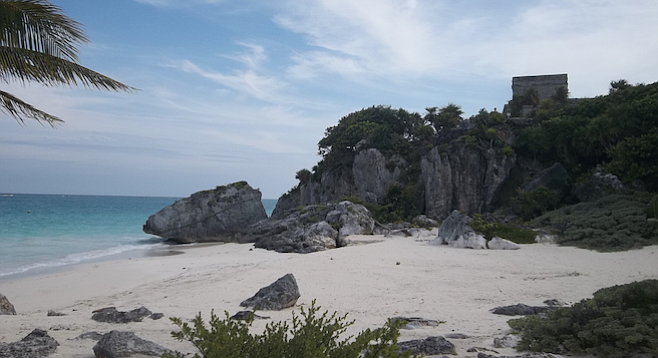
If you tire of lounging about on Cancun's white, sandy beaches and yearn for a bit of Maya culture with your tropical escape, consider exploring the nearby sites of Tulum and Coba. They can both be accessed in one busy, exhilarating day.
While it’s better to see them on separate days, it’s definitely doable to combine the two on a same-day tour or independent visit.
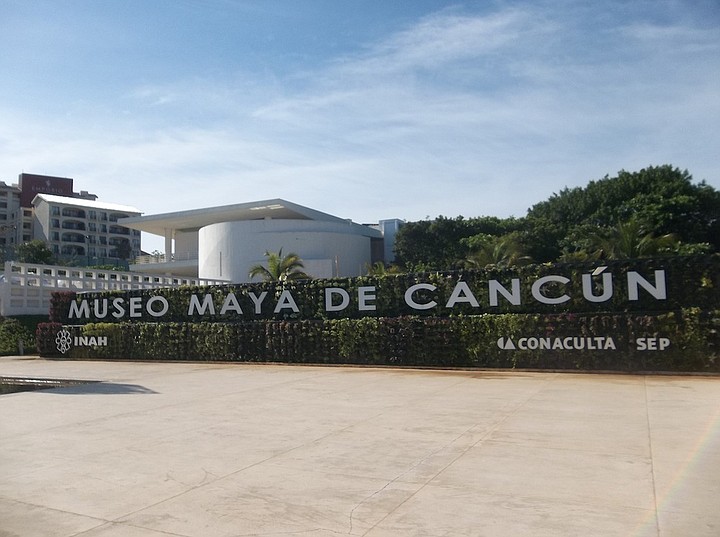
But first, to whet the appetite – and to enhance your knowledge of the Maya civilization – visit the Museo de la Maya. This relatively new museum in Cancun features a comprehensive overview of Maya art and culture.
The museum is small, but a worthwhile introduction to visitors. There are galleries covering the breadth of Maya culture with information in English and preserved archaeological ruins in the garden. It's located in the hotel zone, conveniently within reach if you're staying at one of the beach resorts.

A bus or rental car can bring you to Tulum within two hours. Tulum is a relatively small site, not as grand as Chichen Itza or as historically interesting as Palenque. But oh, the view!
It’s helpful to go with a guide. If you don’t have one, do some research to better understand and appreciate the site and the significance of each structure. There aren’t many trees here to provide shade, so it’s advisable to go in the early morning or late afternoon. It’s also a good idea to bring, sunscreen, a hat, water, and a camera, of course, for the aforementioned view.
Tulum does not cover a large area, so you could conceivably cover it in an hour. But it’s best to linger and savor the magical ambience of the site. If the heat becomes too intense, you can always go down to the beach and take a swim. (Hey, try doing that on a hot, sticky day at Chichen Itza!)
The place is something of a combination archaeological site and beach resort. I looked out at the azure sea beyond the Temple of the Wind and enjoyed a refreshing, late afternoon breeze. If I had brought some wine, I would have toasted the Mayans. Kudos to them for constructing one of their last, great cities on a gorgeous, pristine beach along the turquoise Atlantic.
While in Tulum, I stayed at the Itour Mexico bed & breakfast, a modest budget hotel with a friendly, helpful staff. This place is a great value and just 2 km from the Tulum ruins. I took a leisurely walk to the ruins from Itour, you can also borrow a bike for a pleasant, convenient ride there.
From Tulum or Cancun, a bus can easily take you to the nearby Maya site Coba. It will drop you off alongside the crocodile-infested lake near the site entrance. (Don’t even think about going for a swim here!) It’s best not to bring along any luggage, but if you’re stuck with a bag or two, you can store them for a small fee at the restaurant in front of the bus stop. After entering the site, there's a lengthy, scenic walk to the ruins.
Coba is a large site, so visitors often choose to ride a bike or rent a rickshaw (bicycle taxi). These are available just past the entrance.
Although more spread out than Chichen Itza, I found Coba had a more relaxed vibe due to the lack of crowds and vendors. I also found walking to be more pleasant than at Chichen Itza or Tulum, as there are plenty of jungle trees to provide shade.
Coba flourished between 600 and 900 AD, roughly about the time of nearby Chichen Itza. My guide pointed out the remains of a Maya road that led to Chichen Itza. It's believed that Coba was a trading center between Chichen Itza and locations throughout the Caribbean. A network of over a dozen roads, called the sacbeob, connected Coba with Chichen Itza, Tulum, and other Maya cities.
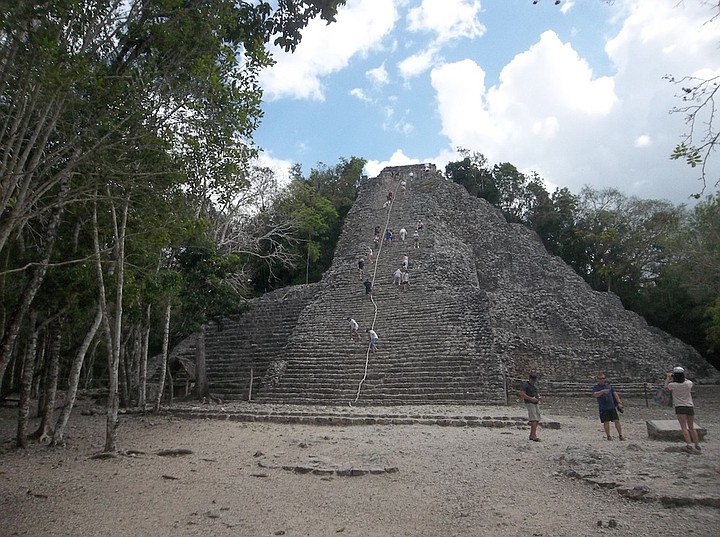
The highlight of a visit to Coba is a climb up the 43-meter-high Nohoch Mol (“large mound” in the Maya language) pyramid. You can hold onto a rope that hangs down the center of the pyramid as you climb – useful for climbers who may experience sudden vertigo. A hundred and twenty-four steps later, once you’ve make it to the top, pause to savor the panoramic view of tropical jungle stretching below to the horizon. A trip here early in the morning or later in the day, when there are few tourists, can provide a transcendent experience that lingers in your memory.
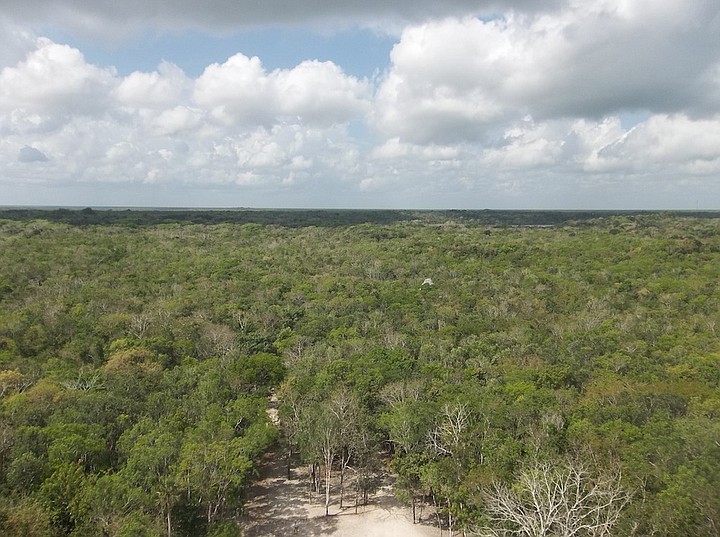
Sidenote: it’s believed that only half the pyramid is above ground, and the rest has yet to be dug up. In fact, Coba might appear quite different in ten or twenty years – amazingly, only 7% of the site has yet been excavated!
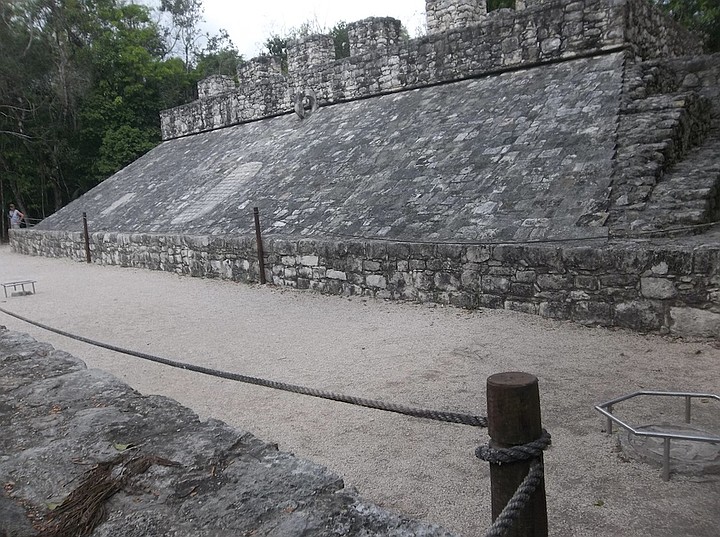
My second favorite structure at Coba is the ball court. There are actually two of them now, as one was recently excavated. It’s worthwhile to research or have a guide explain how the game was played. I’ve heard conflicting accounts at different Maya sites as to whether the losing team was sacrificed or the winning team accepted being sacrificed in order to be ushered into paradise. Perhaps the tradition differed by the site or changed over the centuries.
I took a collectivo back to Tulum from Coba as a convenient alternative to the bus. These privately owned white shuttle vans are a cheap, readily accessible form of transportation in the Yucatan that many visitors seem wary of. Take advantage of them! You can even use them in lieu of renting a car to get from Cancun to Tulum. I saved a fair amount of change taking one from the Cancun airport to the bus station.
You can also request the collectivo to stop at the Gran Cenote on the highway back to Tulum for a refreshing swim or snorkeling break – a welcome respite on a tropical, humid afternoon after a busy day hiking the ruins.
Enjoy the cool, refreshing water and allow visions of Maya pyramids to drift through your consciousness like the cumulus clouds that meander lazily across the Yucatan sky.


If you tire of lounging about on Cancun's white, sandy beaches and yearn for a bit of Maya culture with your tropical escape, consider exploring the nearby sites of Tulum and Coba. They can both be accessed in one busy, exhilarating day.
While it’s better to see them on separate days, it’s definitely doable to combine the two on a same-day tour or independent visit.

But first, to whet the appetite – and to enhance your knowledge of the Maya civilization – visit the Museo de la Maya. This relatively new museum in Cancun features a comprehensive overview of Maya art and culture.
The museum is small, but a worthwhile introduction to visitors. There are galleries covering the breadth of Maya culture with information in English and preserved archaeological ruins in the garden. It's located in the hotel zone, conveniently within reach if you're staying at one of the beach resorts.

A bus or rental car can bring you to Tulum within two hours. Tulum is a relatively small site, not as grand as Chichen Itza or as historically interesting as Palenque. But oh, the view!
It’s helpful to go with a guide. If you don’t have one, do some research to better understand and appreciate the site and the significance of each structure. There aren’t many trees here to provide shade, so it’s advisable to go in the early morning or late afternoon. It’s also a good idea to bring, sunscreen, a hat, water, and a camera, of course, for the aforementioned view.
Tulum does not cover a large area, so you could conceivably cover it in an hour. But it’s best to linger and savor the magical ambience of the site. If the heat becomes too intense, you can always go down to the beach and take a swim. (Hey, try doing that on a hot, sticky day at Chichen Itza!)
The place is something of a combination archaeological site and beach resort. I looked out at the azure sea beyond the Temple of the Wind and enjoyed a refreshing, late afternoon breeze. If I had brought some wine, I would have toasted the Mayans. Kudos to them for constructing one of their last, great cities on a gorgeous, pristine beach along the turquoise Atlantic.
While in Tulum, I stayed at the Itour Mexico bed & breakfast, a modest budget hotel with a friendly, helpful staff. This place is a great value and just 2 km from the Tulum ruins. I took a leisurely walk to the ruins from Itour, you can also borrow a bike for a pleasant, convenient ride there.
From Tulum or Cancun, a bus can easily take you to the nearby Maya site Coba. It will drop you off alongside the crocodile-infested lake near the site entrance. (Don’t even think about going for a swim here!) It’s best not to bring along any luggage, but if you’re stuck with a bag or two, you can store them for a small fee at the restaurant in front of the bus stop. After entering the site, there's a lengthy, scenic walk to the ruins.
Coba is a large site, so visitors often choose to ride a bike or rent a rickshaw (bicycle taxi). These are available just past the entrance.
Although more spread out than Chichen Itza, I found Coba had a more relaxed vibe due to the lack of crowds and vendors. I also found walking to be more pleasant than at Chichen Itza or Tulum, as there are plenty of jungle trees to provide shade.
Coba flourished between 600 and 900 AD, roughly about the time of nearby Chichen Itza. My guide pointed out the remains of a Maya road that led to Chichen Itza. It's believed that Coba was a trading center between Chichen Itza and locations throughout the Caribbean. A network of over a dozen roads, called the sacbeob, connected Coba with Chichen Itza, Tulum, and other Maya cities.

The highlight of a visit to Coba is a climb up the 43-meter-high Nohoch Mol (“large mound” in the Maya language) pyramid. You can hold onto a rope that hangs down the center of the pyramid as you climb – useful for climbers who may experience sudden vertigo. A hundred and twenty-four steps later, once you’ve make it to the top, pause to savor the panoramic view of tropical jungle stretching below to the horizon. A trip here early in the morning or later in the day, when there are few tourists, can provide a transcendent experience that lingers in your memory.

Sidenote: it’s believed that only half the pyramid is above ground, and the rest has yet to be dug up. In fact, Coba might appear quite different in ten or twenty years – amazingly, only 7% of the site has yet been excavated!

My second favorite structure at Coba is the ball court. There are actually two of them now, as one was recently excavated. It’s worthwhile to research or have a guide explain how the game was played. I’ve heard conflicting accounts at different Maya sites as to whether the losing team was sacrificed or the winning team accepted being sacrificed in order to be ushered into paradise. Perhaps the tradition differed by the site or changed over the centuries.
I took a collectivo back to Tulum from Coba as a convenient alternative to the bus. These privately owned white shuttle vans are a cheap, readily accessible form of transportation in the Yucatan that many visitors seem wary of. Take advantage of them! You can even use them in lieu of renting a car to get from Cancun to Tulum. I saved a fair amount of change taking one from the Cancun airport to the bus station.
You can also request the collectivo to stop at the Gran Cenote on the highway back to Tulum for a refreshing swim or snorkeling break – a welcome respite on a tropical, humid afternoon after a busy day hiking the ruins.
Enjoy the cool, refreshing water and allow visions of Maya pyramids to drift through your consciousness like the cumulus clouds that meander lazily across the Yucatan sky.
Comments